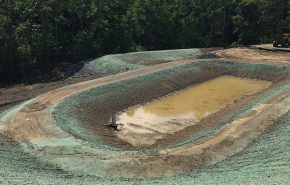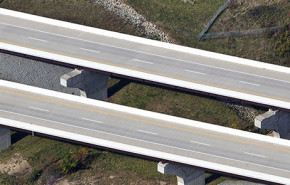Unique Challenges Presented in this High Priority Project
Citizen complaints, pothole issues, car damage payments, and substantial political pressure were all part of the motivation to make the I-264 Pavement Rehabilitation project a priority for the Commonwealth of Virginia. Funded by Virginia’s $6 billion transportation funding bill (HB 2313), this corridor is an important link between neighborhoods, businesses, and oceanfront entertainment. The restoration work, which started in April 2014, will not only provide safer and smoother travel, but will extend the pavement’s lifespan by 15 years or more. “This is not a patching job. This is a complete pavement rehabilitation project. $123 million dollars—it’s the largest pavement project we’ve had in years,” stated VDOT spokesperson Laurie Simmons.
The Design-Build Team of Curtis Contracting, Inc. (Contractor) and GAI Consultants, Inc. (Prime Designer) was awarded the $74.8M, 12-mile segment of this three-phase rehabilitation project, from the Railroad Bridge West of Witchduck Road to Parks Avenue. In an effort to better appreciate the project, below we share insight on its challenges, unique factors, and public communication tactics.
- Heavy Traffic = Night Work. Because of the amount of daily traffic on I-264, all work must be done at night (Sunday – Thursday) to keep the crew safe and minimize disruption to the traveling public. To avoid inconveniencing motorists, crews start at 8 or 9 p.m., after the nightly commute traffic eases, and work until 5 a.m., making sure to get off the road before the morning rush hour begins.
- Fast-track Schedule. The government promised the public a quick turnaround. Starting construction in April 2014, the Team must complete the project in just 19 months—by November 2015. Currently 50% through the schedule, the Team is also halfway done with the work, so they’re right on target to meet their deadline.
- 3 x More Concrete. The Team encountered much worse concrete patching than what they originally anticipated and bid upon. In fact, all design-build teams bid on a fixed quantity of 46,000 square yards of concrete, and it turned out that 120,000 square yards of concrete was actually required. Another important note related to material logistics is that asphalt cannot be laid until concrete patching is completed, which creates a burden on maintaining the project schedule. The Team cuts out the damaged concrete, pours new concrete, and then must wait five hours for it to cure. So there is a very small window to complete what needs to get done each night.
- Work Zone Safety. A number of factors create safety concerns for the Team, including excessive speeds, driver inattention (texting, fatigue, etc.), and driver impairment. Fortunately, there have been no casualties during the project, but accidents occur almost daily. VDOT has implemented an “Orange Cones. No Phones” campaign to raise driver caution while driving through work zones. The Team coordinates with local police to set up DUI checkpoints and speed radar signs to slow traffic (the construction zone is posted at 55 MPH, but drivers typically speed at 60 to 70 MPH). Lastly, additional lanes are sometimes closed to provide a further buffer of protection between workers and speeding traffic; fewer lanes also helps to slow traffic down even further.
- Keeping the Public Informed. The Seventh Point Public Affairs team was hired to communicate the I-264 project scope, impact, and timeline to stakeholders, citizens, and the media. Working on behalf of the VDOT Communications Department, the firm provides updates and milestones, as needed, through direct community outreach, media events, paid media advertising, and social media. To stay up-to-date on the project’s progress, the public can follow @VaDOTHR or search #PavementRehab on Twitter.
Rather than breaking axles, motorists will soon experience smoother, safer, uninterrupted travel on I-264 thanks to this major restoration work.
Rather than breaking axles, motorists will soon experience smoother, safer, uninterrupted travel on I-264 thanks to this major restoration work. It’s a win-win for everyone—residents, visitors, VDOT, and the Commonwealth alike. For more information on the I-264 Pavement Rehabilitation Design-Build project, visit www.repaveHR.com or contact GAI’s Project Manager, Mark Burris, PE, Director, Engineering, at 804.270.9357. For lane closures and alternative routes prior to traveling in work zone areas, watch for VDOT variable message signs, call 511, visit www.511virginia.org, or download Virginia’s free 511 mobile app.


